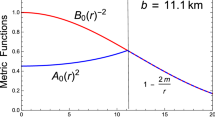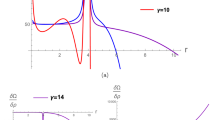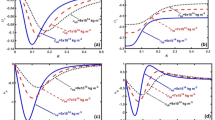Abstract
We investigate the effect of density perturbations and local anisotropy on the stability of stellar matter structures in general relativity using the concept of cracking. Adopting a core-envelope model of a super-dense star, we examine the properties and stability conditions by introducing anisotropic pressure to the envelope region. Furthermore, we propose self-bound compact stars with an anisotropic envelope as a potential progenitor for starquakes. We show how the difference between sound propagation in radial and tangential directions would be used to identify potentially stable regions within a configuration. Due to an increase in the anisotropic parameter, strain energy accumulates in the envelope region and becomes a potential candidate for building-up quake like situation. This stress-energy stored in the envelope region that would be released during a starquake of a self-bound compact star is computed as a function of the magnitude of anisotropy at the core-envelope boundary. Numerical studies for spherically asymmetric compact stars indicate that the stress energy can be as high as \(10^{50}\) erg if the tangential pressure is slightly more significant than the radial pressure. It is happened to be of the same order as the energy associated with giant \(\gamma \)-ray bursts. Thus, the present study will be useful for the correlation studies between starquakes and GRBs.










Similar content being viewed by others
Data availability
No data has been used in this paper and the materials used have been cited in appropriate places.
Code availability
Not applicable.
Notes
Magnetars are the most highly magnetized neutron stars in the cosmos (with magnetic field \(10^{13}\)–\(10^{15}\) G).
Not all branches of sequence \(M=M(\rho _{c})\) are stable. This can be unstable by means of radial oscillations. Degenerate stars with \(\text{d}M/\text{d}\rho _{c}<0\) are found to be unstable and will finally collapse toward Neutron stars, or Black holes.
References
N Itoh Prog. Theor. Exp. Phys. 44 291 (1970)
J Collins and M Perry Phys. Rev. Lett. 34 1353 (1975)
M de Avellar, J Horvath and L Paulucci Phys. Rev. D 84 043004 (2011)
J Horvath and P Moraes Int. J. Mod. Phys. D 30 2150016 (2021)
J Graham and A Fruchter EAS Publ. Series 61 413 (2013)
B Gendre et al ApJ 766 30 (2013)
P Kumar and B Zhang Phys. Rep. 561 1 (2015)
E Nakar Phys. Rep. 442 166 (2007)
E Berger Annu. Rev. Astron. Astrophys. 52 43 (2014)
R .-X Xu, D Tao and Y Yang Mon. Not. R. Astron. Soc. 373 L85 (2006)
C Thompson and R Duncan Mon. Not. R. Astron. Soc. 275 255 (1995)
C Thompson and R C Duncan ApJ 473 322 (1996)
L Franco, B Link and R I Epstein ApJ 543 987 (2000)
G Marranghello, C Vasconcellos and J de Freitas Pacheco Phys. Rev. D 66 064027 (2002)
R Xu ApJ 596 L59 (2003)
C Peng and R Xu Mon. Not. R. Astron. Soc. 384 1034 (2008)
A Zhou, R Xu, X Wu and N Wang Astropart. Phys. 22 73 (2004)
Z Berezhiani, I Bombaci, A Drago, F Frontera and A Lavagno Nuclear Phys. B Proc. Suppl. 113 268 (2002)
R Ouyed and F Sannino Astron. Astrophys. 387 725 (2002)
J Graham et al ApJ 698 1620 (2009)
A Soderberg et al ApJ 650 261 (2006)
J Horvath Mod. Phys. Lett. A 20 2799 (2005)
S Chandrasekhar Phys. Rev. Lett. 12 114 (1964)
K Dev and M Gleiser Gen. Relativ. Gravit. 35 1435 (2003)
L Herrera Phys. Lett. A 165 206 (1992)
A Di Prisco, E Fuenmayor, L Herrera and V Varela Phys. Lett. A 195 23 (1994)
R Chan, L Herrera and N Santos Mon. Not. R. Astron. Soc. 265 533 (1993)
A Di Prisco, L Herrera and V Varela Gen. Relativ. Gravit. 29 1239 (1997)
L Herrera and N Santos Phys. Rep. 286 53 (1997)
M Mak and T Harko Proc. R. Soc. Lond. Series A Math. Phys. Eng. Sci. 459 393 (2003)
G Lemaître. Annales de la Société scientifique de Bruxelles, 53, p 51 (1933)
R Bowers and E Liang Astrophys. J. 188 657 (1974)
W Hillebrandt and K Steinmetz Astron. Astrophys. 53 283 (1976)
G Sagar, B Pandey and N Pant Astrophys. Space Sci. 367 72 (2022)
N Pant, S Gedela, R Pant, J Upreti and R K Bisht Eur. Phys. J. Plus 135 1 (2020)
V Thomas, B Ratanpal and P Vinodkumar Int. J. Mod. Phys. D 14 85 (2005)
R Tikekar and V Thomas Pramana 64 5 (2005)
P Mafa Takisa and S Maharaj Astrophys. Space Sci. 361 1 (2016)
S Gedela, N Pant, J Upreti and R Pant Eur. Phys. J. C 79 1 (2019)
S Mardan, I Noureen and A Khalid Eur. Phys. J. C 81 1 (2021)
N Pant, S Gedela and R K Bisht Chin. J. Phys. 72 530 (2021)
S Gedela, R K Bisht and N Pant Mod. Phys. Lett. A 35 2050097 (2020)
H Abreu, H Hernandez and L Nunez Class. Quantum Gravity 24 4631 (2007)
G González, A Navarro and L Núnez. J. Phys. Conf. Ser. 600 012014. IOP Publishing (2015)
B Ratanpal IOP SciNotes 1 025207 (2020)
E Annala, T Gorda, A Kurkela, J Nättilä and A Vuorinen Nat. Phys. 16 907 (2020)
A Khunt, V Thomas and P Vinodkumar Int. J. Mod. Phys. D 30 2150029 (2021)
X Shu, Y Huang and H Zong Mod. Phys. Lett. A 32 1750027 (2017)
B Link, L Franco and R Epstein Astrophys. J. 508 838 (1998)
S Weinberg. Gravitation and cosmology: principles and applications of the general theory of relativity (John Wiley) (1972)
A Sulaksono Int. J. Mod. Phys. E 24 1550007 (2015)
A Setiawan and A Sulaksono Eur. Phys. J. C 79 1 (2019)
J Lattimer Annu. Rev. Nucl. Part. Sci. 62 485 (2012)
B Abbott et al Phys. Rev. lett. 121 161101 (2018)
M Miller et al Astrophys. J. Lett. 887 L24 (2019)
Y Zeldovich and I Novikov. (Chicago: University of Chicago Press) (1971)
B Harrison, K Throne, M Wakano and J Wheeler. Gravitational Theory and Gravitational Collapse (University of Chicago Press) (1965)
S Saklany, N Pant and B Pandey Phys. Dark Universe. 39 101166 (2023)
T Riley et al Astrophys. J. Lett. 887 L21 (2019)
J Lattimer and M Prakash Astrophys. J. 550 426 (2001)
Zel’dovich. Sov. Phys. JETP 14 (1962)
P Bedaque and A W Steiner Phys. Rev. lett. 114 031103 (2015)
B Reed and C Horowitz Phys. Rev. C 101 045803 (2020)
C C Moustakidis, T Gaitanos, C Margaritis and G Lalazissis Phys. Rev. C 95 045801 (2017)
E Van Oeveren and J Friedman Phys. Rev. D 95 083014 (2017)
Y Ma and M Rho Phys. Rev. D 100 114003 (2019)
H Bondi Proc. R. Soc. Lond. Series A Math. Phys. Sci. 281 39 (1964)
P Haensel, A Potekhin and D Yakovlev. Neutron Stars 1 (Springer) (2007)
D Ravenhall and C Pethick Astrophys. J. 424 846 (1994)
K Thorne Astrophys. J. 212 825 (1977)
O Blaes, R Blandford, P Goldreich and P Madau ApJ 343 839 (1989)
P Mock and P Joss ApJ 500 374 (1998)
A Watts et al Rev. Mod. Phys. 88 021001 (2016)
Funding
Not applicable.
Author information
Authors and Affiliations
Contributions
(i) Khunt: Conceptualization, methodology, analytical and numerical calculation, manuscript preparation; (ii) Thomas: investigation, writing-review,; (iii) Vinodkumar: writing-review, calculation-analysis.
Corresponding author
Ethics declarations
Conflict of interest
The authors declare that they have no conflict of interest.
Additional information
Publisher's Note
Springer Nature remains neutral with regard to jurisdictional claims in published maps and institutional affiliations.
Rights and permissions
Springer Nature or its licensor (e.g. a society or other partner) holds exclusive rights to this article under a publishing agreement with the author(s) or other rightsholder(s); author self-archiving of the accepted manuscript version of this article is solely governed by the terms of such publishing agreement and applicable law.
About this article
Cite this article
Khunt, A.C., Thomas, V.O. & Vinodkumar, P.C. Relativistic stellar modeling with perfect fluid core and anisotropic envelope fluid. Indian J Phys 97, 3379–3393 (2023). https://doi.org/10.1007/s12648-023-02692-1
Received:
Accepted:
Published:
Issue Date:
DOI: https://doi.org/10.1007/s12648-023-02692-1





